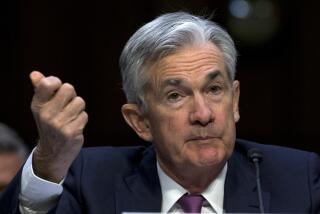Inflation Fears? Heed Tokyo’s Experience : Interest rates: The U.S. can take lessons from the disaster that followed Japan’s rate hikes.
President Clinton’s two recent nominees to the seven-member Federal Reserve Board should add weight to arguments against further interest-rate increases. Their confirmation by the Senate is urgent, given that the Fed has again taken action to raise interest rates.
The Fed’s measures could dampen the recovery that we have seen recently in California and return the state to the economic doldrums of the past few years.
The impact of monetary policies is brutally evident in the Japanese recession that has now entered its fourth year, having shaken a once-booming economy to the core. It is a recession exacerbated by mistakes in economic policy at the hands of the Bank of Japan--Tokyo’s counterpart to the Federal Reserve System.
The name of the Bank of Japan’s governor is Mieno, which literally means “threefold” in Japanese. There is irony in the name, for Mieno actually made three major errors in his handling of monetary policy.
First, having experienced the runaway inflation of the early to mid-1970s, when consumer price increases at their peak reached 30% per year in Japan, Mieno was obsessed by the prospect that inflation might rekindle. Although high inflation was not imminent, he raised the discount rate sharply after taking office in late 1989. That key rate rose by almost 2 percentage points within a few months in 1990. Mieno kept interest rates at high levels until mid-1991, when the economy had already fallen into a recessionary spiral.
Mieno, for his second error, did not recognize the importance of the stock market to the overall economy, and ignored the warning sounded by the collapse of the Tokyo stock market in 1990. He even regarded these market declines as a desirable correction from the so-called “bubble economy” of the 1980s.
And finally, Mieno apparently believed that unlike other advanced economies, Japan’s economic health was so robust that his high interest policy could not substantially retard the growth of the real economy. He never expected that a tight monetary policy would lead Japan to the worst recession in the postwar era.
Although Mieno came to realize in 1992 that his fight against inflation was stifling Japan’s economy, he was reluctant to cut the discount rate for fear of being accused of reversing his stand against speculation in the securities and real-estate markets. As a result of his tight-money policies, the Japanese economy is still suffering from major declines in asset values and from very high “real” interest rates. Even though the nominal interest rates may appear low, the current Japanese deflation rate is about 2% a year on the wholesale level. The “real” rates are therefore about 2% above the percentage actually charged.
Mieno’s mistakes have taken their toll, and Japan has had near-zero growth for some time. While U.S. conditions are not the same, there are enough comparisons to cause concern. Rapid interest-rate hikes by the Federal Reserve have spooked the financial markets and triggered substantial declines. Perhaps they would have occurred anyway, but that is surely no reason for the Fed to lead the charge.
The national economy is poised for a major recovery. But this expansion can quickly be halted by a dose of monetary restraint. With the example of the Japanese recession in mind, President Clinton’s new appointees, White House economic adviser and Princeton professor Alan Blinder and UC Berkeley economist Janet Yellen, would do well to curb the Fed’s excessive fears of inflation.
California is still poised for recovery--if only the Fed can restrain its own hand.
More to Read
Inside the business of entertainment
The Wide Shot brings you news, analysis and insights on everything from streaming wars to production — and what it all means for the future.
You may occasionally receive promotional content from the Los Angeles Times.










